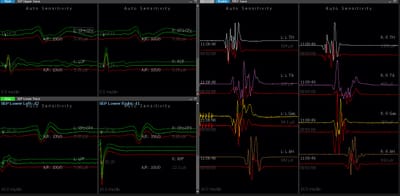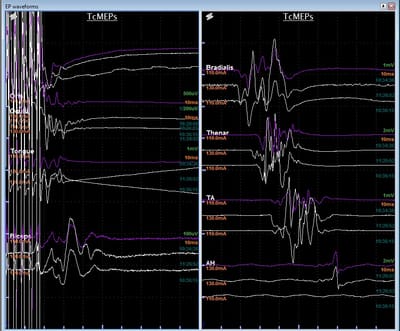Intraoperative neurophysiology
Intraoperative neurophysiology is monitoring electrical activity of the brain during brain tumour operations. This technology has a large variety of applications in brain tumour surgery depending on the scenario. Electrodes on the surface of the skull, the surface of the brain, and in peripheral muscles (arm, leg, face, tongue) can provide real-time information about the integrity of functional pathways in the brain.
When operations are carried out under a general anaesthetic and feedback from the patient is not possible, intraoperative neurophysiology allows monitoring of the integrity of specific pathways inside the brain (movement, sensation, vision). Continuous electrical stimulation emitted by our instruments is used as a real-time warning system of proximity to important pathways inside the brain substance. This information allows us to perform more radical tumour resections at a lower risk of neurological deficit.
During awake operation, cortical and subcortical stimulation of the brain in combination with intraoperative clinical observations allows to assess speech (expression of speech, understanding, repetition), ability to read, movement, visual fields. During awake surgery when the risk of intraoperative seizures is high, cortical electrodes monitor the electrical activity of the surface of the brain and act as an early warning system for intraoperative epilepsy.
When operations are carried out under a general anaesthetic and feedback from the patient is not possible, intraoperative neurophysiology allows monitoring of the integrity of specific pathways inside the brain (movement, sensation, vision). Continuous electrical stimulation emitted by our instruments is used as a real-time warning system of proximity to important pathways inside the brain substance. This information allows us to perform more radical tumour resections at a lower risk of neurological deficit.
During awake operation, cortical and subcortical stimulation of the brain in combination with intraoperative clinical observations allows to assess speech (expression of speech, understanding, repetition), ability to read, movement, visual fields. During awake surgery when the risk of intraoperative seizures is high, cortical electrodes monitor the electrical activity of the surface of the brain and act as an early warning system for intraoperative epilepsy.

